Regarding the Sine Wave: This article will explain the information below.
- How to obtain RMS Value, Average Value, Form Factor, and Crest Factor
RMS Value, Average Value, Form Factor, and Crest Factor of Sine Wave
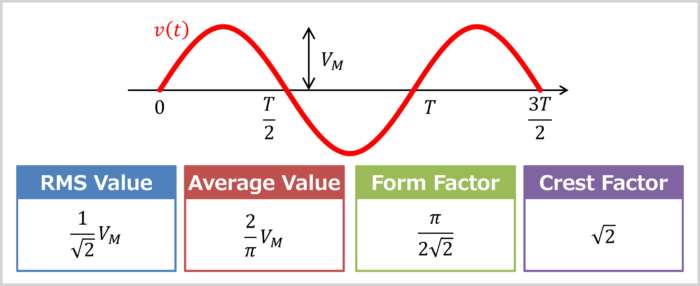
The first illustration shows the root mean square (RMS) value, average value, form factor, and crest factor of a sine wave (with a maximum value of \(V_M\) and a period of \(T\)).
Now, let's explain how each of these values are calculated (we strive to include as many intermediate steps as possible).
Waveform of a Sine Wave
To find the root mean square (RMS) value and average value of a sine wave, we first need to express the sine wave as a formula.
Here is the waveform of a sine wave:

In the above figure, the sine wave can be represented by the following formula:
\begin{eqnarray}
v(t)=V_M\sin{{\omega}t}
\end{eqnarray}
Using the above formula, we can calculate the root mean square (RMS) value, average value, form factor, and peak factor of the sine wave.
However, calculations become a bit complex with this formula.
Therefore, for easier computation, we will convert the time axis (horizontal axis \(t\))) to the phase axis (change the horizontal axis to \({{\omega}t}\)).
About the benefits and method of converting the time axis (horizontal axis t) to the phase axis (horizontal axis ωt)
Benefits of Conversion
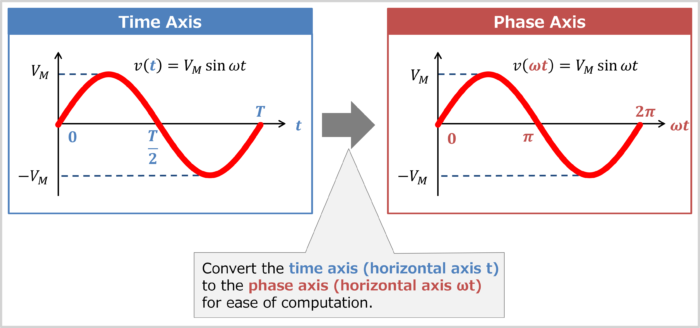
For instance, if you integrate \(\sin{{\omega}t}\) with respect to time \(t\), you get the following equation:
\begin{eqnarray}
\displaystyle \int \sin{{\omega}t} dt = -\displaystyle \frac{1}{\omega}\cos{{\omega}t} +C\\
C:\mbox{constant of integration}
\end{eqnarray}
Integrating with respect to time \(t\) introduces \({\omega}\) in the denominator, making the calculation complex.
On the other hand, if you integrate \(\sin{{\omega}t}\) with respect to phase \({{\omega}t}\), you get:
\begin{eqnarray}
\displaystyle \int \sin{{\omega}t} d({{\omega}t}) = -\cos{{\omega}t} +C\\
C:\mbox{constant of integration}
\end{eqnarray}
As you can see from the above equation, integrating with respect to phase \({{\omega}t}\) does not introduce \({\omega}\) in the denominator. Therefore, it simplifies the calculation.
Method of Conversion
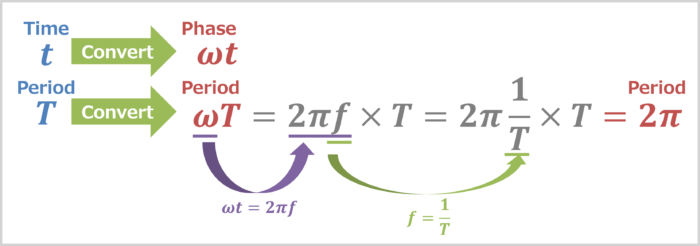
Let's explain the method of conversion.
Since time is "\(t\)" and phase is "\({{\omega}t}\)", to convert time \(t\) into phase \({{\omega}t}\), you multiply time \(t\) by \({\omega}\).
If you represent the period at time \(t\) as \(T\), the period at phase \({{\omega}t}\) is obtained by multiplying the period \(T\) by \({\omega}\).
The calculation is as follows:
\begin{eqnarray}
\mbox{Period at phase}~~{{\omega}t}={\omega}T=2{\pi}f×T=2{\pi}\displaystyle \frac{1}{T}×T=2{\pi}
\end{eqnarray}
From here, we will use the phase axis (horizontal axis \({{\omega}t}\)) in the figure below to calculate the root mean square, average value, form factor, and peak factor of the sine wave.
RMS Value of a Sine Wave
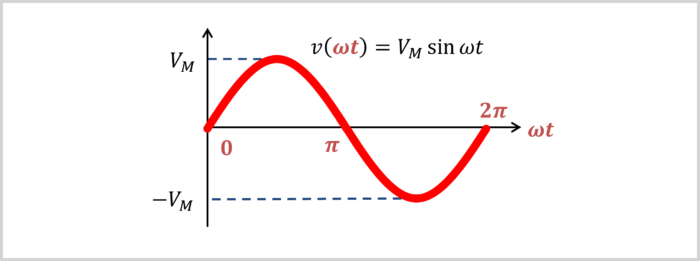
The root mean square (RMS) value \(V_{RMS}\) of a waveform \(v({{\omega}t})\) is the square root of the mean of the square of \(v({{\omega}t})\). It can be represented by the following formula:
\begin{eqnarray}
V_{RMS} &=& \sqrt{\displaystyle\frac{1}{2\pi} \displaystyle \int_{0}^{2\pi}v({{\omega}t})^2d({{\omega}t}})
\end{eqnarray}
In the above formula, if you let
\begin{eqnarray}
X &=& \displaystyle \int_{0}^{2\pi}v({{\omega}t})^2 d({\omega}t)
\end{eqnarray}
then the root mean square (RMS) value \(V_{RMS}\) of a waveform \(v({{\omega}t})\) can be represented by the following formula:
\begin{eqnarray}
V_{RMS} &=& \sqrt{\displaystyle\frac{1}{2\pi} X}
\end{eqnarray}
Next, we calculate the value of \(X\).
\begin{eqnarray}
X &=& \displaystyle \int_{0}^{2\pi}v({{\omega}t})^2 d({\omega}t)\\
\\
&=& \displaystyle \int_{0}^{2\pi}{V_M}^2{\sin}^2{\omega}t d({\omega}t)\\
\\
&=& {V_M}^2\displaystyle \int_{0}^{2\pi}{\sin}^2{\omega}t d({\omega}t)\\
\\
&=& {V_M}^2\displaystyle \int_{0}^{2\pi}\displaystyle \frac{1-{\cos2{\omega}t}}{2} d({\omega}t)\\
\\
&=& {V_M}^2 \left[\frac{1}{2}{{\omega}t}-\frac{1}{4}{\sin2{\omega}t} \right]_{0}^{2\pi}\\
\\
&=& {V_M}^2 \left( \frac{1}{2}×{2\pi}-\frac{1}{4}{\sin{4\pi}}\right)\\
\\
&=& {V_M}^2 {\pi}
\end{eqnarray}
Therefore, the root mean square (RMS) value \(V_{RMS}\) of a waveform \(v({{\omega}t})\) becomes:
\begin{eqnarray}
V_{RMS} &=&\sqrt{\displaystyle\frac{1}{2\pi} X}\\
\\
&=&\sqrt{\displaystyle\frac{1}{2\pi} {V_M}^2 {\pi}}\\
\\
&=&\displaystyle\frac{V_M}{\sqrt{2}}
\end{eqnarray}
Average Value of a Sine Wave
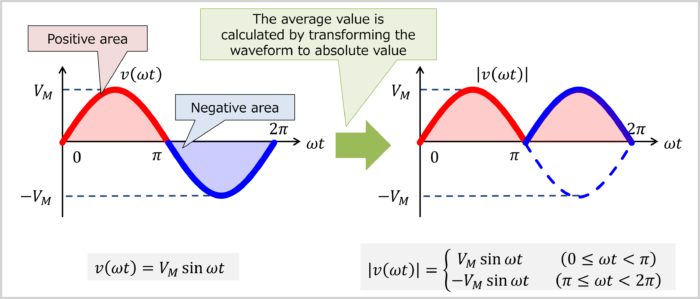
The average value \(V_{AVE}\) of a waveform \(v({{\omega}t})\) is the average value of the absolute value \(|v({{\omega}t})|\) of \(v({{\omega}t})\) and can be represented by the following formula:
\begin{eqnarray}
V_{AVE} &=& \displaystyle\frac{1}{2\pi} \displaystyle \int_{0}^{2\pi}|v({{\omega}t})|d({{\omega}t})
\end{eqnarray}
This formula for calculating the average value uses the absolute value \(|v({{\omega}t})|\) of \(v({{\omega}t})\).
Therefore, you need to convert the negative region of the waveform (the lightly shaded blue area) to positive (the lightly shaded red area).
For the region \(\left(0 \leq {\omega}t \lt \pi \right)\), where the waveform \(v({{\omega}t})\) is positive, no conversion is necessary.
For the region \(\left(\pi \leq {\omega}t \lt 2\pi \right)\), where the waveform \(v({{\omega}t})\) is negative, you must multiply by -1 to make it positive.
Therefore, the absolute value \(|v({{\omega}t})|\) of \(v({{\omega}t})\) can be represented by the following formula:
\begin{eqnarray}
|v({{\omega}t})| = \begin{cases}
V_M\sin{{\omega}t} & \left(0 \leq {\omega}t \lt \pi\right) \\
\\
-V_M\sin{{\omega}t} & \left(\pi \leq {\omega}t \lt 2\pi\right)
\end{cases}
\end{eqnarray}
In the formula to calculate the average value, if we separate each part, we get:
\begin{eqnarray}
V_{AVE} &=& \displaystyle\frac{1}{2\pi} \displaystyle \int_{0}^{2\pi}|v({\omega}t)|d({{\omega}t})\\
\\
&=& \displaystyle\frac{1}{2\pi}\left(\displaystyle \int_{0}^{\pi}V_M\sin{{\omega}t}d({{\omega}t})+ \int_{\pi}^{2\pi}-V_M\sin{{\omega}t}d({{\omega}t}) \right)\\
\end{eqnarray}
This formula integrates the absolute value \(|v({{\omega}t})|\) of \(v({{\omega}t})\) over the region from \(0\) to \(2\pi\) and then divides by \(2\pi\) to find the average value.
However, if we consider the diagram, integrating over the region from \(0\) to \(\pi\) and then dividing by \(\pi\) yields the same average value.
Conceptually, it is as shown in the figure below:
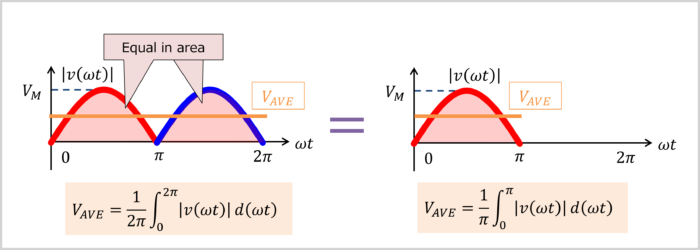
Therefore, the average value of the absolute value \(|v({{\omega}t})|\) of \(v({{\omega}t})\) can be calculated by the following formula:
\begin{eqnarray}
V_{AVE} &=& \displaystyle\frac{1}{\pi} \displaystyle \int_{0}^{\pi}|v({\omega}t)|d({{\omega}t})\\
\\
&=& \displaystyle\frac{1}{\pi}\displaystyle \int_{0}^{\pi}V_M\sin{{\omega}t}d({{\omega}t})
\end{eqnarray}
If we calculate the above formula, the average value \(V_{AVE}\) of the sine wave becomes:
\begin{eqnarray}
V_{AVE} &=& \displaystyle\frac{1}{\pi}\displaystyle \int_{0}^{\pi}V_M\sin{{\omega}t}d({{\omega}t})\\
\\
&=& \displaystyle\frac{1}{\pi}V_M\left[-\cos{\omega}t \right]_{0}^{\pi}\\
\\
&=& \displaystyle\frac{V_M}{\pi}\left(-\cos\pi - \cos0 \right)\\
\\
&=& \displaystyle\frac{2V_M}{\pi}
\end{eqnarray}
Form Factor of a Sine Wave
The form factor can be represented by the following formula:
\begin{eqnarray}
\mbox{Form Factor} &=& \displaystyle\frac{\mbox{Root Mean Square Value}~~V_{RMS}}{\mbox{Average Value}~~V_{AVE}}
\end{eqnarray}
Since we've already calculated the root mean square (RMS) value \(V_{RMS}\) and average value \(V_{AVE}\) of the sine wave, we can substitute these values into the formula to calculate the form factor of the sine wave.
\begin{eqnarray}
\mbox{Form Factor} = \displaystyle\frac{\displaystyle\frac{V_M}{\sqrt{2}}}{\displaystyle\frac{2V_M}{\pi}} = \displaystyle\frac{\pi}{2\sqrt{2}}
\end{eqnarray}
Maximum Value of a Sine Wave
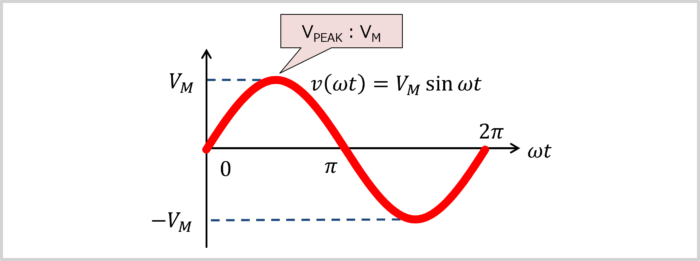
As can be seen from the waveform, the maximum value \(V_{PEAK}\) of a sine wave is represented by the following value:
\begin{eqnarray}
\mbox{Maximum Value}~~V_{PEAK}=V_M
\end{eqnarray}
Crest Factor of a Sine Wave
The Crest factor can be represented by the following formula:
\begin{eqnarray}
\mbox{Crest Factor} &=& \displaystyle\frac{\mbox{Peak Value}~~V_{PEAK}}{\mbox{Root Mean Square Value}~~V_{RMS}}
\end{eqnarray}
Since we've already calculated the root mean square (RMS) value \(V_{RMS}\) and peak value \(V_{PEAK}\) of the sine wave, we can substitute these values into the formula to calculate the peak factor (crest factor) of the sine wave.
The Crest factor of the sine wave is represented by the following value:
\begin{eqnarray}
\mbox{Crest Factor} = \displaystyle\frac{V_M}{\displaystyle\frac{V_M}{\sqrt{2}}} = \sqrt{2}
\end{eqnarray}
Summary
In this article, the following information on the "Sine Wave" was explained.
- How to obtain RMS Value, Average Value, Form Factor, and Crest Factor
Thank you for reading.